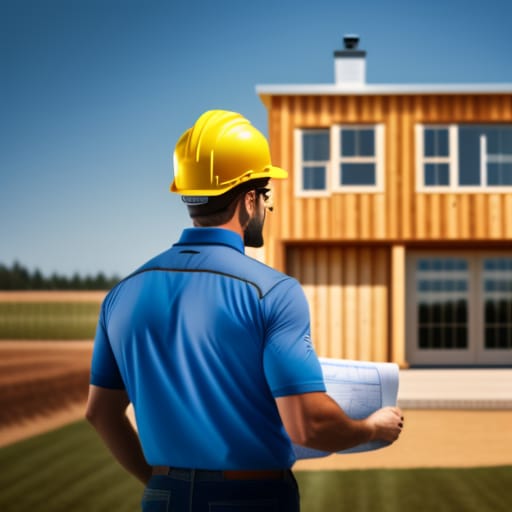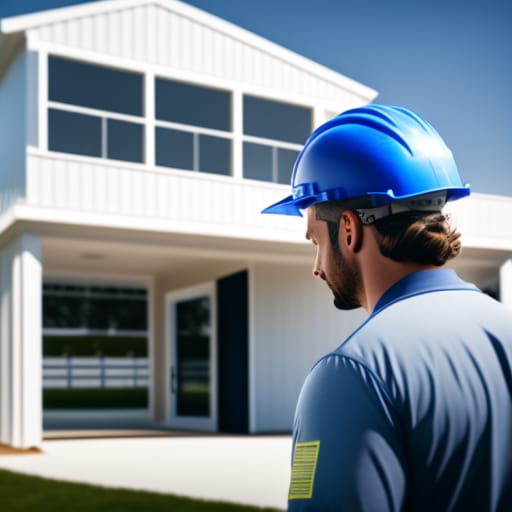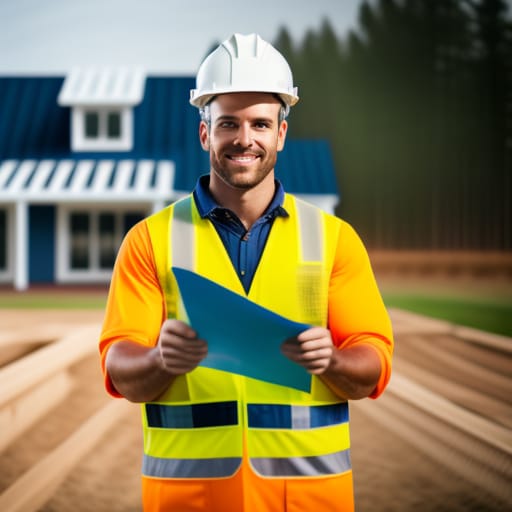Constructing a house from the ground up is an exciting endeavor that requires careful planning and execution. Like any large project, it’s important to understand the fundamental concepts and components that serve as the building blocks for bringing your dream home to life. In this beginner’s guide, we will explore the key terms, players, materials, and steps involved in house construction to give you a solid foundation of knowledge.

An Introduction to House Building Basics
House construction is a complex process that involves multiple professionals, tradespeople, materials, and build stages. Before diving into the specifics, it helps to understand some basic terminology and background on residential construction.
Some key terms to know:
- Contractor: The professional who manages your house-building project and subcontractors. They may also provide construction services directly.
- Subcontractors: Specialized professionals hired by the general contractor to complete specific tasks like plumbing, electrical, framing, etc.
- Building permit: Legal permission from your local municipality to begin construction, ensures compliance with building codes.
- Footings and foundation: Support structures constructed from concrete that transfer the weight of the house into the ground.
- Framing: The skeletal structure of the house is made of wood or steel that provides shape and supports the roof, walls, and floors.
- MEP systems: Mechanical, electrical, and plumbing systems that enable a house to function.
The evolution of house construction
Home-building techniques have evolved enormously over human history, from primitive mud huts and log cabins to today’s highly advanced framed houses. Key innovations like the balloon frame method in the 1800s allowed for faster, affordable construction. The use of standardized dimensional lumber enabled the mass production of housing components. New materials like engineered wood, steel, and composites offer even greater capabilities today.
The significance of building blocks
Like any complex endeavor, house construction relies on basic foundational elements as the “building blocks” to create the finished product. Understanding these core components provides the knowledge to successfully undertake a home build project.
Key Players in Your House Build Team
Constructing a house requires a team of professionals with specialized expertise across various disciplines. Here are the key players you’ll want to have on your house construction crew:
General Contractor
- Manages the entire building project
- Oversees specialized subcontractors
- May provide some direct construction services
- Helps obtain permits and coordinates inspections
Subcontractors
- Electricians – install electrical systems
- Plumbers – install pipes, toilets, sinks
- HVAC technicians – install heating and AC systems
- Roofers – construct and install roof
- Drywall installers – install interior wall surfaces
Architect
- Designs the architectural plans for the house
- Ensures design meets local building codes
- Can assist with material and color selection
Engineer
- Designs structural elements like foundation and framing
- Confirms designs meet building codes
- Assesses environmental factors like soil type
Interior Designer
- Plans interior layouts and decor elements
- Selects finishes, furniture, and fittings
- Oversees interior styling like paint colors
Key Materials in House Construction
Quality materials are essential for constructing a sturdy, durable, and functional home. Here are some of the most important building materials used in residential builds:
- Concrete – Foundations, footings, slabs
- Lumber – Framing, finishes
- Plywood – Sheathing, floors
- Drywall – Interior walls and ceilings
- Insulation – Batts, spray foam
- Roofing – Shingles, metal roofing
- Siding – Brick, stone, vinyl, wood
- Windows – Vinyl, aluminum, wood
- Doors – Interior, exterior, garage
- Plumbing – Pipes, fittings, sinks, toilets
- Electrical – Wiring, lighting, switches
- HVAC – Furnace, ductwork, vents
- Flooring – Tile, hardwood, carpet
Selecting quality brand-name building products backed by warranties ensures your home is constructed to last.
Stages of House Construction
While every home build is unique, the construction process generally follows these key phases:
Planning and Permits
- Architectural designs finalized
- Engineering plans completed
- Permits applied for and approved
- Utility connections coordinated
Site Preparation
- Lot surveyed and marked
- Trees/debris removed
- Topsoil stripped and stockpiled
Foundation
- Footings were dug and concrete poured
- Foundation walls constructed
- Slab or basement floor poured
- Utility rough-ins installed
Framing
- Floors joists and subfloor installed
- Exterior walls erected and sheathed
- Roof trusses set and sheathed
- Interior walls constructed
Mechanicals
- HVAC systems installed
- Plumbing pipes and fixtures installed
- Electrical wiring and boxes installed
- Insulation added throughout
Exterior Finishes
- Roofing, siding, stone, and bricks installed
- Windows and doors installed
- Painting or staining complete
- Driveways and walkways poured
Interior Finishes
- Drywall installation and finishing
- Cabinets and trims installed
- Flooring, countertops, and fixtures installed
- Painting completed
- Lighting, and plumbing fixtures installed
Landscaping and Site Drainage
- Final grading and drainage
- Plantings, trees, and sod laid
- Patios, decking, and fencing constructed
Inspections and Occupancy
- Final inspections passed
- Certificate of Occupancy obtained
- Utilities transferred to the owner
Understanding this build sequence helps set expectations and plan the budget and timeline.
Safety First – Vital Safety Measures
Safety should always be the number one priority on any construction site. Follow these essential safety practices during your home build:
- Require all workers to wear hard hats, eye protection, and steel-toe boots
- Ensure ladders and scaffolding meet standards and are properly set up
- Keep first-aid kits on-site and train workers in basic first-aid
- Use ground fault circuit interrupters (GFCIs) on all power tools
- Avoid carbon monoxide poisoning by venting fumes from generators
- Erect warning signs and boundary fences around excavations
- Enforce zero tolerance for alcohol or drugs on-site
- Keep fire extinguishers on hand and ban smoking inside the home
- Stay on top of debris cleanup to prevent slip and fall injuries
Following rigorous safety protocols is crucial to prevent tragic accidents and injuries.

Cost Considerations
Constructing a new single-family home is a significant investment, with costs varying based on size, materials, and location. Here are some typical price ranges:
| Item | Cost Range |
|---|---|
| Land acquisition | $15,000 – $200,000+ |
| Architectural plans | $20,000 – $50,000 |
| Permits | $1,000 – $5,000 |
| Site work | $15,000 – $30,000 |
| Foundation | $20,000 – $50,000 |
| Framing materials | $25,000 – $60,000 |
| Roofing | $10,000 – $30,000 |
| Windows | $7,000 – $20,000 |
| Siding | $10,000 – $25,000 |
| Plumbing | $10,000 – $30,000 |
| Electrical | $15,000 – $35,000 |
| HVAC | $8,000 – $15,000 |
| Insulation | $5,000 – $12,000 |
| Drywall | $10,000 – $26,000 |
| Interior finishings | $20,000 – $150,000 |
| Appliances | $5,000 – $15,000 |
| Total Cost | $200,000 – $500,000+ |
This overview gives an idea of the significant budgets required for a new home build. Carefully estimating costs and setting contingencies is advised.
Choosing Your House Plans
Selecting the right house design plan is an exciting early step in the build process. Consider the following:
- How many bedrooms and bathrooms do you need?
- Any special spaces like a home office?
- What architectural style do you prefer? Modern, farmhouse, colonial?
- What special features are important like a big kitchen, media room, etc.?
- Will you need an attached or detached garage? How many cars?
- What size lot will the home be built on?
- What is your overall target square footage?
- Are there any constraints like HOA rules to consider?
Working through these questions will help refine your needs so the architect can design the ideal custom home plan. Review multiple design options before finalizing plans.
Selecting Your Construction Team
Your contractor and subcontractors will make or break the success of your house build. Use these tips to assemble a great construction team:
- Ask friends/neighbors for referrals
- Verify licenses and insurance
- Check reviews and ratings online
- Evaluate years in business and experience
- Interview multiple companies before deciding
- Ask for and check references
- Review portfolios of completed projects
- Clearly communicate your budget and expectations
- Trust your gut feeling during interviews
Taking time to carefully vet and select your home builder is a worthwhile investment.
Construction Loan Basics
Since construction projects take significant time, specific construction loans are typically required versus conventional mortgages. Key features include:
- Only pay interest on what you borrow as you go
- Loan disbursements based on completed work
- Interest rates are slightly higher than conventional loans
- Require 10-25% downpayment
- Lower credit score requirements
- Convert to regular mortgage after building complete
Talk to a reputable lender experienced with construction loans to fund your build.
The Building Permit Process
Building permits are mandatory for home construction and renovations to ensure compliance with local zoning and building codes. Here’s what’s involved:
- Research permit requirements for your municipality
- Work with architect to finalize permit-ready plans
- Submit completed permit application and documents
- Pay required permit fees, which vary by location
- Wait for permit review and inspection process
- Make any revisions requested
- Receive approved building permit
- Display permit on-site throughout construction
- Schedule any required inspections throughout the build
- Obtain a certificate of occupancy upon completion
Allow plenty of time for permitting, a critical path item for construction.
Key Inspections
Your home build must pass a series of inspections at different construction stages before continuing. Common inspections include:
Foundation & Footings – Ensures proper depth and reinforcement
Framing & Rough-ins – Checks framing, electrical, plumbing, HVAC
Insulation – Verifies adequate insulation per code
Drywall – Check for fire blocks, nailing
Final – Confirms all work meets code requirements
Your general contractor will coordinate scheduling inspectors. Be sure to allow buffers in your timeline for any needed re-inspections. Passing these milestones is essential to stay on track.
Construction Management Software
From start to finish, constructing a home generates huge amounts of data, documents, and details. Construction management software helps organize everything in one centralized system with features like:
- File storage and sharing
- Drawing and model viewing
- Task and schedule management
- Change order and submission tracking
- Material ordering and procurement
- Purchase order generation
- Payment processing
- Punch list and closeout management
This technology provides transparency and control over your important construction project.
Tips for Avoiding Cost Overruns
Even the best-planned construction projects can encounter unexpected issues that increase costs. Here are some tips for avoiding major budget overruns:
- Get multiple bids to establish accurate cost estimates
- Build in at least 10% contingency for unknowns
- Sign a fixed-price contract with your contractor if possible
- Communicate all change orders in writing and understand pricing
- Review invoices closely before approving payments
- Watch for subcontractor change requests that increase pricing
- Assign someone to carefully monitor spending and progress
- Address problems immediately to avoid bigger issues
- Stick to your pre-approved selection finishes to avoid upgrades
- Have set checkpoints for review costs compared to the budget
Proactive communication and diligent oversight go a long way toward sticking to your budget.
Essential Questions for Your Contractor
Choosing the right general contractor is critical for success. Get answers to these key questions during interviews:
- How long have you been in the construction business?
- How many home builds have you completed?
- Will you be hands-on during the entire project?
- Do you carry the proper licenses and insurance?
- What are your qualifications and training?
- Who are your key subcontractors that you work with?
- Can you share 2-3 homeowner references?
- What is your approach if we disagree on something?
- How do you prefer to communicate during construction?
- How will you share updates and keep me informed about progress?
- Do you offer fixed-price or cost-plus contracts?
- What specific allowances and exclusions are in your contract?
- What are your payment draw terms and schedule?
Their responses will reveal if they are an experienced, communicative pros who will be a great partner on your build.
Optimizing Energy Efficiency
Building an energy-efficient home saves money and also reduces environmental impact. Be sure to consider:
- High insulation levels in walls, attics, and foundations
- ENERGY STAR-rated windows, appliances, lighting
- Tight construction and ductwork to prevent air leakage
- Passive solar design and strategic use of landscaping
- High-efficiency HVAC and water heating systems
- Smart thermostats and home automation systems
- Solar panels or other renewable energy options
- Electric vehicle charging stations in garage
- Water-saving faucets, showers, toilets, and irrigation
There are many opportunities throughout design and construction to optimize the performance of your home.
Personalizing with Smart Customizations
In addition to the essential elements, incorporating special custom features creates a home tailored to your unique needs and desires:
Home Office Spaces
- Built-in workstations and cubbies
- Shelving and storage for supplies
- Additional phone/data connections
- Soundproofing
- Skylights or additional lighting
Home Theater
- Pre-wiring for A/V equipment
- Dimmer switches and theater lighting
- Blackout curtains and window treatments
- Acoustic panels on walls for sound
- Tiered seating or riser
Game Room
- Wet bar with sink and mini-fridge
- Durable flooring that withstands traffic
- Lots of power outlets and USB charging
- Sound system built into ceiling with volume controls
- Good acoustics to absorb noise
- Special lighting like neon signs
Work closely with your designer to include elements that personalize your space.
Converting an Outbuilding into a Barndominium
Barndominiums have become a popular new home option. Key considerations for converting an outbuilding into living space:
Budget
- Costs $100-$300 per sq. ft depending on finishes and extent of renovation needed
Foundation
- May need foundation reinforcement to support living loads
Insulation
- Add high R-Value spray foam insulation in walls and ceilings
Electrical and Plumbing
- Provide power, lighting, outlets to code
- Install water supply, septic/sewage, bathrooms
HVAC
- Install ductwork and efficient heating/cooling system
Interior
- Frame walls to create bedrooms, living spaces
- Include kitchen, baths, laundry facilities
- Finish and trim carpentry
Barndominiums allow repurposing existing structures into cozy homes with a unique character.
Smart Home Technology
Today’s home automation systems allow unprecedented control, convenience, and efficiency through smart technology:
- Control lighting, climate, security, and more from your phone or voice
- Create customized scenes like “Movie Night” at the touch of a button
- Integrate third-party devices like locks, cameras, appliances
- Receive notifications if water is detected, doors are opened, etc.
- Monitor home status and energy use from anywhere
- Automatically adjust settings around your schedule and preferences
- Remotely grant access to visitors like dog walkers or contractors
Outfitting your home with smart technology results in greater comfort, security, and peace of mind.

Final Thoughts
Constructing your dream home is one of the most rewarding and exciting endeavors you can undertake. Though the process is complex, understanding the fundamentals provides a strong foundation. Do your homework to assemble the right team and plans. Stay involved and proactive in your build project. Be prepared for challenges but keep focused on the vision of your ideal living space. Your patience and persistence will pay off when you can finally move into a home tailor-made to your unique needs and tastes. With sound information and the right approach, you’ll be well on your way to a successful build and years of happiness in your new home.
Frequently Asked Questions
What are the main construction stages when building a new home?
The major construction stages include: site preparation, foundation work, framing, roofing, mechanical systems, exterior finishes, interior finishes, final inspections and occupancy. The general contractor will coordinate all the subcontractors and oversee the schedule to complete each stage. Expect the total construction build-out to take 8-12 months on average.
What framing and roofing materials are best?
For framing, dimensional lumber like 2x4s and 2x6s are typical for wood-framed houses. Engineered wood I-joists offer strong, lightweight options too. The roof structure is often framed with wooden or pre-fabricated trusses sheathed with plywood. Asphalt shingles are the most common economical roofing material, but metal roofing is also popular for its longevity.
How do I budget for site work and foundation costs?
Plan around $15,000-$30,000 for basic site preparation tasks like clearing and grading. The foundation can range from $20,000-$50,000 depending on size and complexity; a basic slab foundation is most affordable. Work with your contractor to understand what is included.
Should I use a construction loan to finance my build?
Yes, a construction loan that disburses payments at set milestones is the best way to fund a custom build. This avoids paying interest on the full mortgage amount before you can move in. Expect about 10-25% downpayment and a slightly higher interest rate.
What inspections are required during construction?
Common inspections include the foundation, framing, mechanical systems, insulation, plumbing, electrical, and final inspection. Your contractor will coordinate these with the building inspector to obtain the certificate of occupancy before move-in.